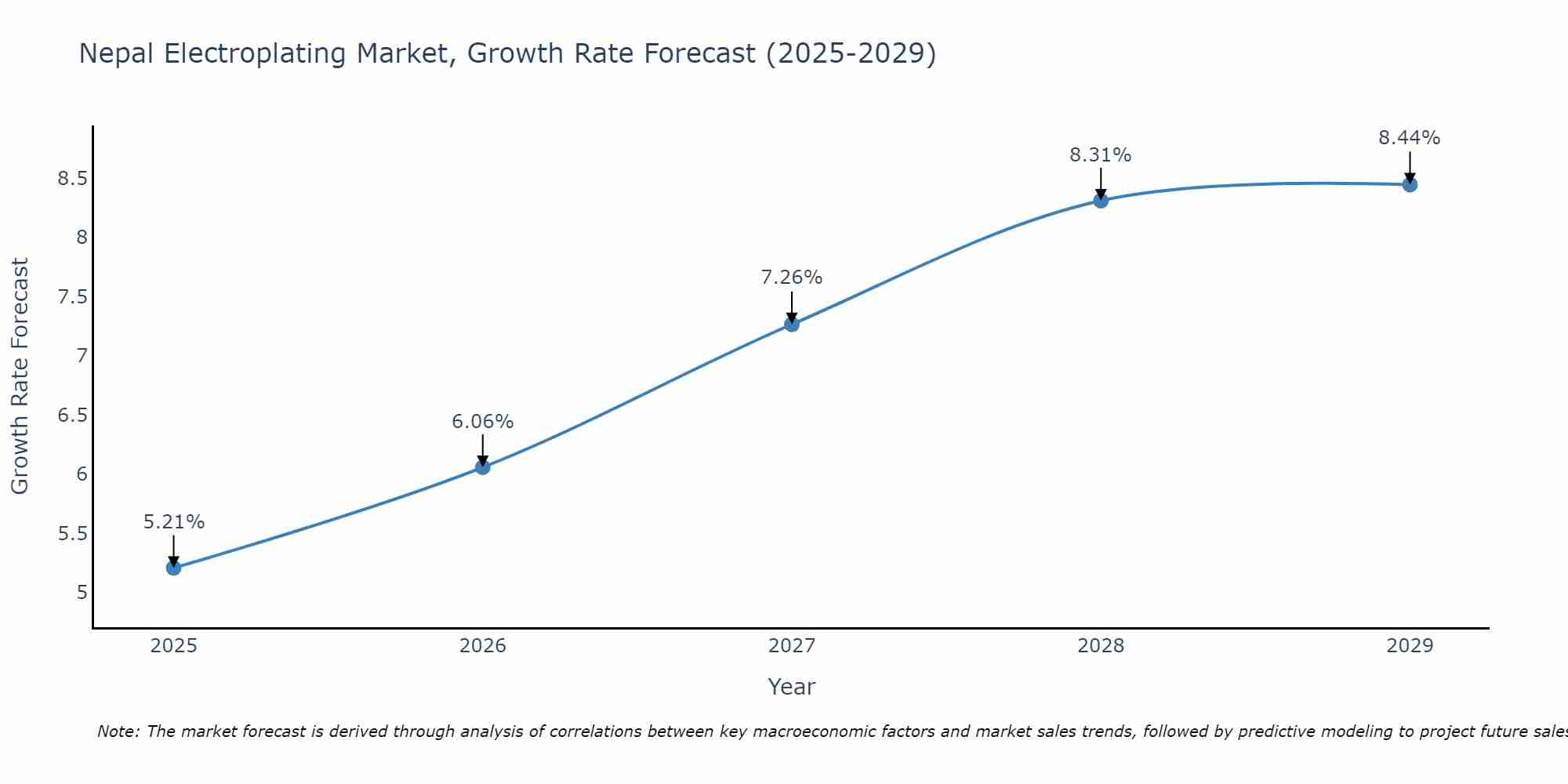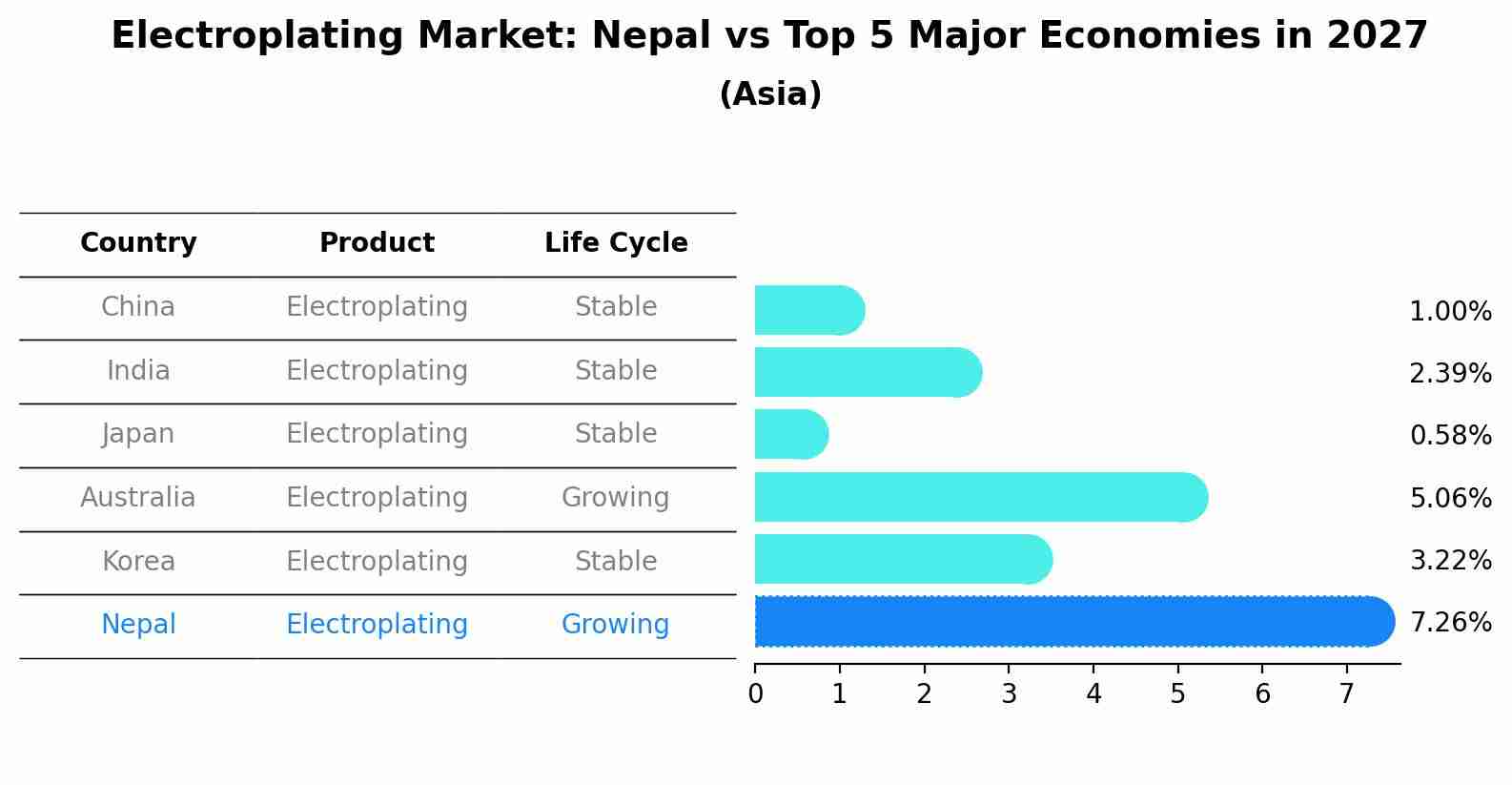Nepal Electroplating Market (2025-2031) Outlook | Size, Industry, Analysis, Forecast, Trends, Share, Value, Companies, Growth & Revenue
| Product Code: ETC104635 | Publication Date: Jun 2021 | Updated Date: Jun 2025 | Product Type: Report | |
| Publisher: 6Wresearch | Author: Shubham Padhi | No. of Pages: 70 | No. of Figures: 35 | No. of Tables: 5 |
Nepal Electroplating Market Size Growth Rate
The Nepal Electroplating Market is likely to experience consistent growth rate gains over the period 2025 to 2029. Commencing at 5.21% in 2025, growth builds up to 8.44% by 2029.

Electroplating Market: Nepal vs Top 5 Major Economies in 2027 (Asia)
The Electroplating market in Nepal is projected to grow at a growing growth rate of 7.26% by 2027, highlighting the country's increasing focus on advanced technologies within the Asia region, where China holds the dominant position, followed closely by India, Japan, Australia and South Korea, shaping overall regional demand.

Nepal Electroplating Market Overview
The Nepal Electroplating Market is witnessing steady growth driven by increasing industrial activities and demand for surface finishing solutions across various sectors such as automotive, electronics, and manufacturing. The market is characterized by the presence of both small-scale local players and larger established companies offering a range of electroplating services including nickel, chrome, zinc, and copper plating. Rising awareness about the benefits of electroplating in enhancing the aesthetics, durability, and corrosion resistance of metal components is fueling market expansion. Additionally, stringent environmental regulations are encouraging the adoption of sustainable electroplating techniques to minimize the impact on the environment. Overall, the Nepal Electroplating Market presents opportunities for companies to innovate, invest in technology, and cater to the evolving needs of industries looking for high-quality surface finishing solutions.
Nepal Electroplating Market Trends
The Nepal Electroplating Market is experiencing a shift towards environmentally friendly and sustainable practices, driven by increasing awareness of the environmental impact of traditional electroplating processes. Companies are investing in technologies that reduce waste generation, improve energy efficiency, and minimize the use of hazardous chemicals. There is also a growing demand for specialized electroplating services to cater to industries such as automotive, electronics, and jewelry, which require high-quality surface finishing for their products. Additionally, the market is witnessing a trend towards automation and digitization to enhance productivity and quality control. Overall, the Nepal Electroplating Market is evolving towards more sustainable and efficient practices to meet the needs of a changing industry landscape.
Nepal Electroplating Market Challenges
In the Nepal Electroplating Market, several challenges are prevalent. One major challenge is the lack of advanced technology and equipment, leading to lower efficiency and quality standards compared to international counterparts. Additionally, environmental regulations and waste disposal issues pose significant challenges as many electroplating processes involve the use of hazardous chemicals. Another challenge is the limited availability of skilled labor with expertise in electroplating techniques, hindering the industry`s growth potential. Moreover, the market faces stiff competition from imported electroplated products, which often offer higher quality at competitive prices. Overall, addressing these challenges through investments in technology, training programs, and sustainable practices is crucial for the Nepal Electroplating Market to enhance its competitiveness and sustainability in the long run.
Nepal Electroplating Market Investment Opportunities
In the Nepal Electroplating Market, there are several investment opportunities for both local and international investors. With the country`s growing industrial sector and increasing demand for high-quality surface finishing in various industries such as automotive, electronics, and jewelry, investing in electroplating services and facilities can be lucrative. Additionally, as the government focuses on promoting manufacturing and industrial growth through initiatives like the "Make in Nepal" campaign, there is a positive outlook for the electroplating market. Investors can consider setting up modern electroplating facilities, introducing eco-friendly plating technologies, or providing specialized services to cater to the diverse needs of the market. Collaborating with local businesses and manufacturers can also help in establishing a strong presence and capturing a significant market share in Nepal`s electroplating industry.
Nepal Electroplating Market Government Policy
Government policies related to the Nepal Electroplating Market include regulations on waste management, pollution control, and worker safety. The government has implemented guidelines to ensure proper disposal of hazardous chemicals used in the electroplating process, as well as measures to reduce air and water pollution caused by electroplating activities. Additionally, there are regulations in place to protect the health and safety of workers in electroplating facilities, such as providing proper training and equipment to prevent accidents and exposure to harmful substances. Compliance with these policies is monitored by government agencies to maintain environmental sustainability and promote safe working conditions within the Nepal Electroplating Market.
Nepal Electroplating Market Future Outlook
The Nepal Electroplating Market is poised for steady growth in the coming years due to increasing industrial activities and the growing demand for electroplated products in various sectors such as automotive, electronics, and construction. The market is expected to benefit from advancements in technology, which will lead to improved efficiency and quality of electroplating processes. Additionally, the government`s initiatives to promote domestic manufacturing and attract foreign investment are likely to drive the market further. However, the industry may face challenges related to environmental regulations and the need for sustainable practices. Overall, with the right strategies and investments in place, the Nepal Electroplating Market is expected to expand and offer opportunities for both existing players and new entrants.
Key Highlights of the Report:
- Nepal Electroplating Market Outlook
- Market Size of Nepal Electroplating Market, 2021
- Forecast of Nepal Electroplating Market, 2031
- Historical Data and Forecast of Nepal Electroplating Revenues & Volume for the Period 2021 - 2031
- Nepal Electroplating Market Trend Evolution
- Nepal Electroplating Market Drivers and Challenges
- Nepal Electroplating Price Trends
- Nepal Electroplating Porter's Five Forces
- Nepal Electroplating Industry Life Cycle
- Historical Data and Forecast of Nepal Electroplating Market Revenues & Volume By Metal for the Period 2021 - 2031
- Historical Data and Forecast of Nepal Electroplating Market Revenues & Volume By Gold for the Period 2021 - 2031
- Historical Data and Forecast of Nepal Electroplating Market Revenues & Volume By Copper for the Period 2021 - 2031
- Historical Data and Forecast of Nepal Electroplating Market Revenues & Volume By Nickel for the Period 2021 - 2031
- Historical Data and Forecast of Nepal Electroplating Market Revenues & Volume By Others for the Period 2021 - 2031
- Historical Data and Forecast of Nepal Electroplating Market Revenues & Volume By Type for the Period 2021 - 2031
- Historical Data and Forecast of Nepal Electroplating Market Revenues & Volume By Barrel Plating for the Period 2021 - 2031
- Historical Data and Forecast of Nepal Electroplating Market Revenues & Volume By Rack Plating for the Period 2021 - 2031
- Historical Data and Forecast of Nepal Electroplating Market Revenues & Volume By Continuous Plating for the Period 2021 - 2031
- Historical Data and Forecast of Nepal Electroplating Market Revenues & Volume By Line Plating for the Period 2021 - 2031
- Historical Data and Forecast of Nepal Electroplating Market Revenues & Volume By End-User Industry for the Period 2021 - 2031
- Historical Data and Forecast of Nepal Electroplating Market Revenues & Volume By Automotive for the Period 2021 - 2031
- Historical Data and Forecast of Nepal Electroplating Market Revenues & Volume By Electrical and Electronics for the Period 2021 - 2031
- Historical Data and Forecast of Nepal Electroplating Market Revenues & Volume By Aerospace and Defense for the Period 2021 - 2031
- Historical Data and Forecast of Nepal Electroplating Market Revenues & Volume By Medical for the Period 2021 - 2031
- Historical Data and Forecast of Nepal Electroplating Market Revenues & Volume By Others for the Period 2021 - 2031
- Nepal Electroplating Import Export Trade Statistics
- Market Opportunity Assessment By Metal
- Market Opportunity Assessment By Type
- Market Opportunity Assessment By End-User Industry
- Nepal Electroplating Top Companies Market Share
- Nepal Electroplating Competitive Benchmarking By Technical and Operational Parameters
- Nepal Electroplating Company Profiles
- Nepal Electroplating Key Strategic Recommendations
Frequently Asked Questions About the Market Study (FAQs):
- Single User License$ 1,995
- Department License$ 2,400
- Site License$ 3,120
- Global License$ 3,795
Search
Thought Leadership and Analyst Meet
Our Clients
Related Reports
- Germany Breakfast Food Market (2026-2032) | Industry, Share, Growth, Size, Companies, Value, Analysis, Revenue, Trends, Forecast & Outlook
- Australia Briquette Market (2025-2031) | Growth, Size, Revenue, Forecast, Analysis, Trends, Value, Share, Industry & Companies
- Vietnam System Integrator Market (2025-2031) | Size, Companies, Analysis, Industry, Value, Forecast, Growth, Trends, Revenue & Share
- ASEAN and Thailand Brain Health Supplements Market (2025-2031) | Strategy, Consumer Insights, Analysis, Investment Trends, Opportunities, Growth, Size, Share, Industry, Revenue, Segments, Value, Segmentation, Supply, Forecast, Restraints, Outlook, Competition, Drivers, Trends, Demand, Pricing Analysis, Competitive, Strategic Insights, Companies, Challenges
- ASEAN Bearings Market (2025-2031) | Strategy, Consumer Insights, Analysis, Investment Trends, Opportunities, Growth, Size, Share, Industry, Revenue, Segments, Value, Segmentation, Supply, Forecast, Restraints, Outlook, Competition, Drivers, Trends, Demand, Pricing Analysis, Competitive, Strategic Insights, Companies, Challenges
- Europe Flooring Market (2025-2031) | Outlook, Share, Industry, Trends, Forecast, Companies, Revenue, Size, Analysis, Growth & Value
- Saudi Arabia Manlift Market (2025-2031) | Outlook, Size, Growth, Trends, Companies, Industry, Revenue, Value, Share, Forecast & Analysis
- Uganda Excavator, Crane, and Wheel Loaders Market (2025-2031) | Strategy, Consumer Insights, Analysis, Investment Trends, Opportunities, Growth, Size, Share, Industry, Revenue, Segments, Value, Segmentation, Supply, Forecast, Restraints, Outlook, Competition, Drivers, Trends, Demand, Pricing Analysis, Competitive, Strategic Insights, Companies, Challenges
- Rwanda Excavator, Crane, and Wheel Loaders Market (2025-2031) | Strategy, Consumer Insights, Analysis, Investment Trends, Opportunities, Growth, Size, Share, Industry, Revenue, Segments, Value, Segmentation, Supply, Forecast, Restraints, Outlook, Competition, Drivers, Trends, Demand, Pricing Analysis, Competitive, Strategic Insights, Companies, Challenges
- Kenya Excavator, Crane, and Wheel Loaders Market (2025-2031) | Strategy, Consumer Insights, Analysis, Investment Trends, Opportunities, Growth, Size, Share, Industry, Revenue, Segments, Value, Segmentation, Supply, Forecast, Restraints, Outlook, Competition, Drivers, Trends, Demand, Pricing Analysis, Competitive, Strategic Insights, Companies, Challenges
Industry Events and Analyst Meet
Whitepaper
- Middle East & Africa Commercial Security Market Click here to view more.
- Middle East & Africa Fire Safety Systems & Equipment Market Click here to view more.
- GCC Drone Market Click here to view more.
- Middle East Lighting Fixture Market Click here to view more.
- GCC Physical & Perimeter Security Market Click here to view more.
6WResearch In News
- Doha a strategic location for EV manufacturing hub: IPA Qatar
- Demand for luxury TVs surging in the GCC, says Samsung
- Empowering Growth: The Thriving Journey of Bangladesh’s Cable Industry
- Demand for luxury TVs surging in the GCC, says Samsung
- Video call with a traditional healer? Once unthinkable, it’s now common in South Africa
- Intelligent Buildings To Smooth GCC’s Path To Net Zero


















